October 9th, 2013
| 1 Comment »
I love October. I love everything about it, from it’s blazing maples and fiery Sumac to the clear, crisp nights of abundant stars, the scent of woodsmoke floating on the chilled air. I love that switch to snugglier clothes and another blanket on the bed. I love a simmering soup pot, a pan of fragrant cornbread, baking with apples and fresh-pressed, rich apple cider
I just LOVE October!
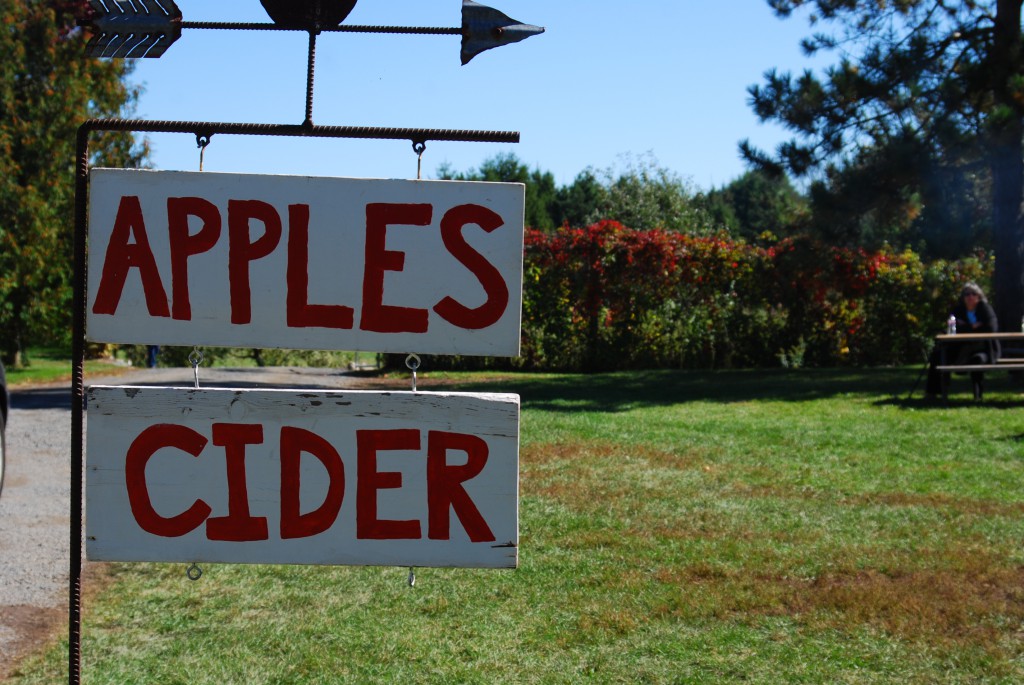
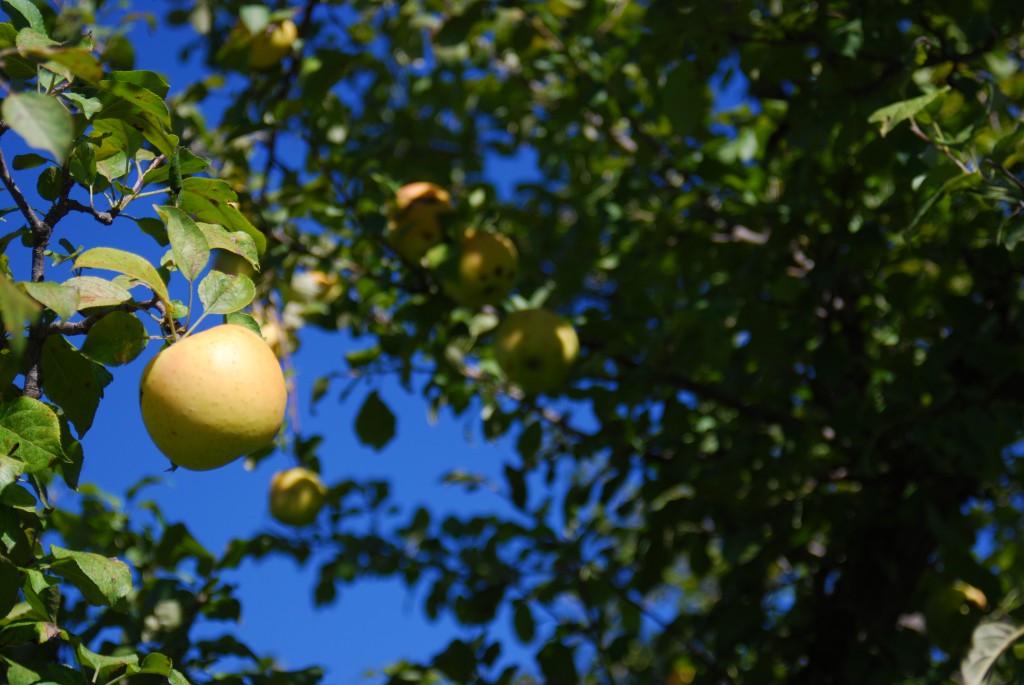
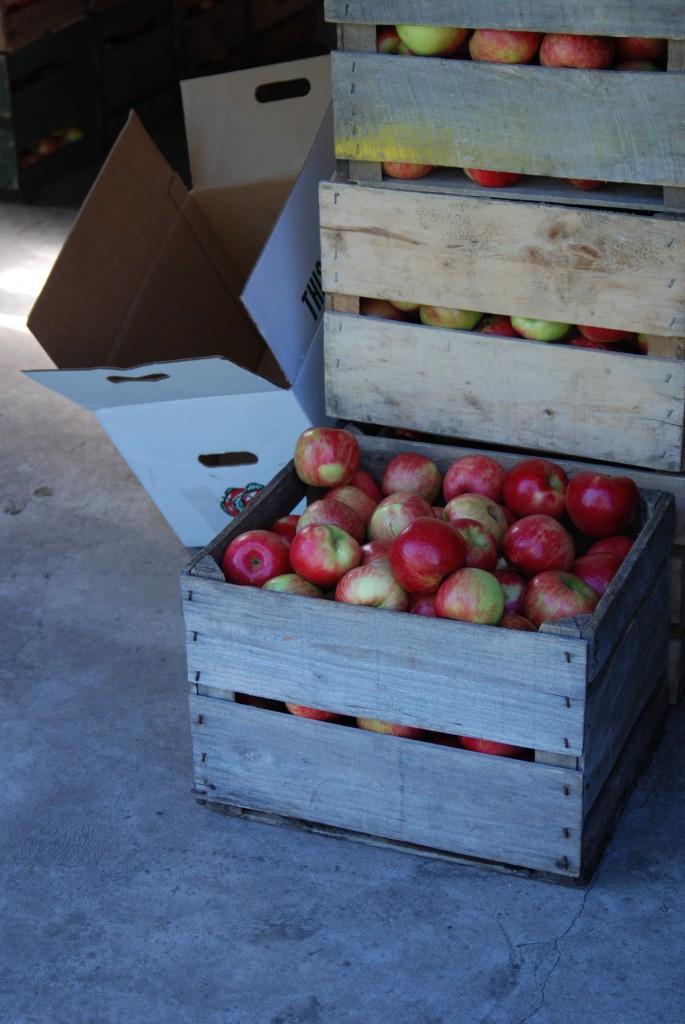




I haven’t always loved Ratatouille, though. And I’ve made it multiple ways that have been OK, to an extent, but haven’t been so wonderful that I jumped at a chance to repeat the recipe. Yet every year, when the abundance of zucchini and eggplant and tomato is all there, ready and waiting to be slowly cooked together in this classic peasant dish, I always want to try something again.
There are so many ways to make a simple dish like this.
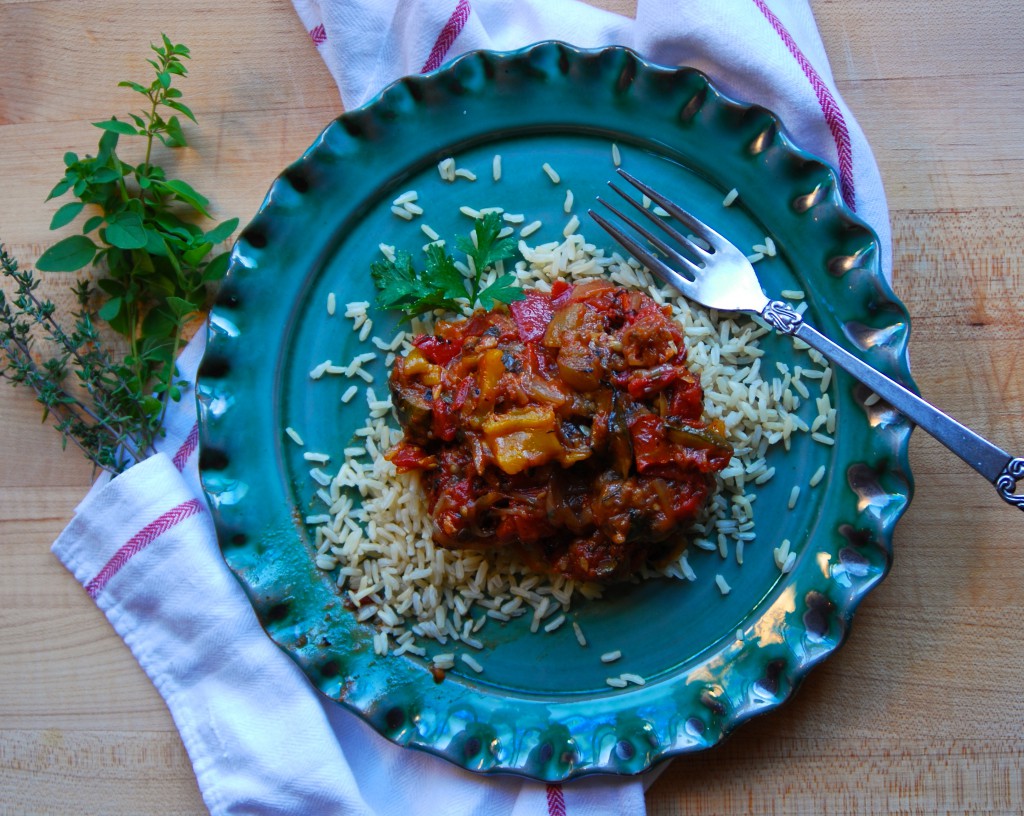
This recipe I would repeat. Over and over again. While it is a bit extensive, with the grilling and the simmering, the end result is well worth the extra effort. This Ratatouille was silky smooth and simply melted in my mouth, with hints of smokiness from the grill. And as all good dishes go, it was even better the next day.
This recipe does not use fresh tomatoes, and I love the rich flavor that fire-roasted canned tomatoes gives it. Feel free to use fresh if you wish, knowing you will lose some of that smoky taste if you do.
Ratatouille, Grilled and Simmered
3 small zucchini, sliced horizontally
1 medium eggplant, peeled and sliced into 1/2″ slices
2 medium onions, sliced thin
3 cloves garlic, finely minced
1 each red, yellow and orange bell pepper, gutted and halved
1 28-oz can fire roasted tomatoes (strongly suggested for the amazing flavor they will add- sub in fresh if you wish)
1/2 c. good quality olive oil
1/4 c. balsamic vinegar
1/4 c. mixed fresh herbs, like oregano, thyme, parsley, basil, all finely minced
2 t. smoked paprika (smoked is preferred; use regular if it’s all you have)
Salt and pepper
Whisk the olive oil and balsamic vinegar together in a measuring cup. Brush a small amount on one side of the eggplant slices, being careful not to spread on too much. Brush some on the zucchini and reserve the remaining oil/vinegar mix for later.
In a 6-qt stockpot, heat a small drizzle of olive oil and add the sliced onions. Cook over medium heat, stirring occasionally, until the onions are opaque. Add the garlic, reduce the heat and cook, stirring often, until the onions and garlic are very soft.
While the onions cook, heat your grill, and when hot, place the peppers, skin side down on the hottest part. Add the sliced zucchini and eggplant, and cook until tender and slightly charred for all vegetables. Place peppers in a bowl and cover with plastic wrap to steam so you can remove the skin. Rough chop the zucchini and eggplant and add to the pan with the onions, stirring to combine. Drizzle in a small amount of the oil/vinegar mix to moisten and add the smoked paprika. When cool enough to handle, skin the peppers and rough chop those, adding to the pan, along with the can of tomatoes. Stir everything, get it simmering, then reduce the heat and cover the pan. Allow it to cook, slowly, for 30 minutes. Stir it once or twice to insure it isn’t sticking. Reduce heat if it is, and drizzle a bit more of the oil/vinegar mix in, if needed.
Season to taste with salt and pepper, and add in half the fresh herbs. Allow to simmer about 5 more minutes. Stir, taste and season more, if needed. Serve warm or room temperature, over brown rice or pasta, or with a thick, hearty bread to soak up the juices.
KATE’S NOTES: I am nuts for fire-roasted tomatoes and have tried multiple brands, always coming back to Muir Glen Organic. The taste is bar none for a canned product- it tastes like tomato right off the vine! You can use fresh tomato in this dish if that’s your thing, but the extra fire-roasted taste will lend well to the final result, along with the grilled and charred vegetables.
The smoked paprika also adds a nice deep, smoky flavor, and has been one of my most favorite spices to add to just about everything lately. You will get a much different taste if you use regular paprika.
February 10th, 2012
| 4 Comments »
There is something so perfect about a pot of soup, one that steams and seems to sing from the stovetop, humming it’s warmth throughout my kitchen, through my skin and right in to my bones. I feel the need for soup, sometimes as deep as the roots of my hair and permeating outward, and as any good Midwestern girl knows, when the cold winds scour you down and the light is so flat and gray and weak that it makes you weary and drawn, then soup, in all it’s aromatic glory and flavor, can be a shot of lifeblood that runs through you, chasing the chill away.
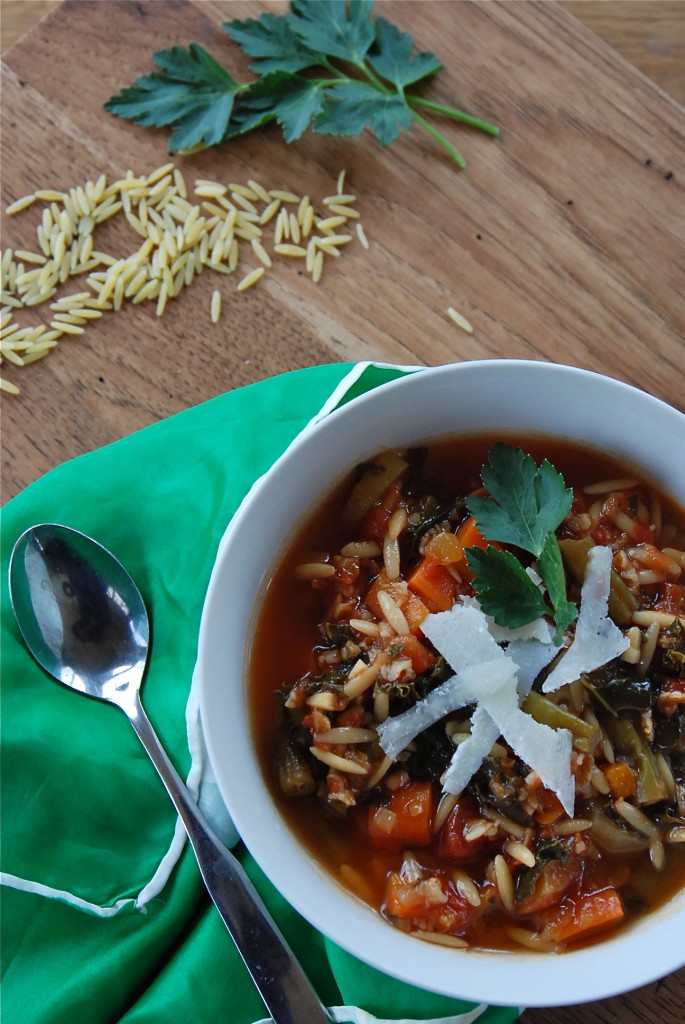
Soup has but a few simple secrets to making it shine, such as taking some time to caramelize the vegetables to form a flavor base, a good broth or stock to add more depth and a shot of love, really, to not rush the process. But good soup really starts from need. Or craving and desire.
I used to not be all that good at making soup, mostly because I just didn’t understand why a recipe that looked so simple could often turn out so darn wrong. I wanted depth, a rich flavor that penetrated the spoon and it’s contents, making it something so much more than broth and vegetables. All I really needed was a bit of patience, a lot of practice and tad more salt. Don’t be afraid of a shake of salt over that simmering pot, as it is the one ingredient that can transform a simple pot of soup to one that shimmers it’s warmth right down to your toes.
This Minestrone soup, as all Minestrone soups go, really has no clear outline, no real etymology. It creates itself for the most part, out of what you have on hand, and what you like in your soup. Or, like me on this particular cold January night, it leapt from under my hands out of sheer need. I couldn’t get warm, couldn’t shake a chill that had settled in my core like a wicked internal frost. Somehow, this chill and it’s accompanying rattle in my brain sounded like it was saying, over and over “Make Minestrone!” and I moved, on automatic it seemed, from fridge to stove to cupboard, seeking and searching ingredients. There were the green beans languishing in the drawer and in dire straits, there was Pomi tomatoes (my favorite packaged tomato- so amazingly fresh and flavorful) and there were thick, deeply orange carrots, fat tear-jerking onions, a partial box of orzo, a few zucchini beginning to look slightly sorry for themselves, just enough kale, a bounty of fresh oregano and parsley. And while the fragrance filled the house, and the soup simmered it’s coherent and rhythmic blup-blup-blup on the stove, a quick search for dunking material in the freezer yielded a container of croutons, spiked with herbs and olive oil, that I’d made from a loaf of stale semolina bread. Did I mention another key ingredient to perfect soup just might be a touch of serendipity?
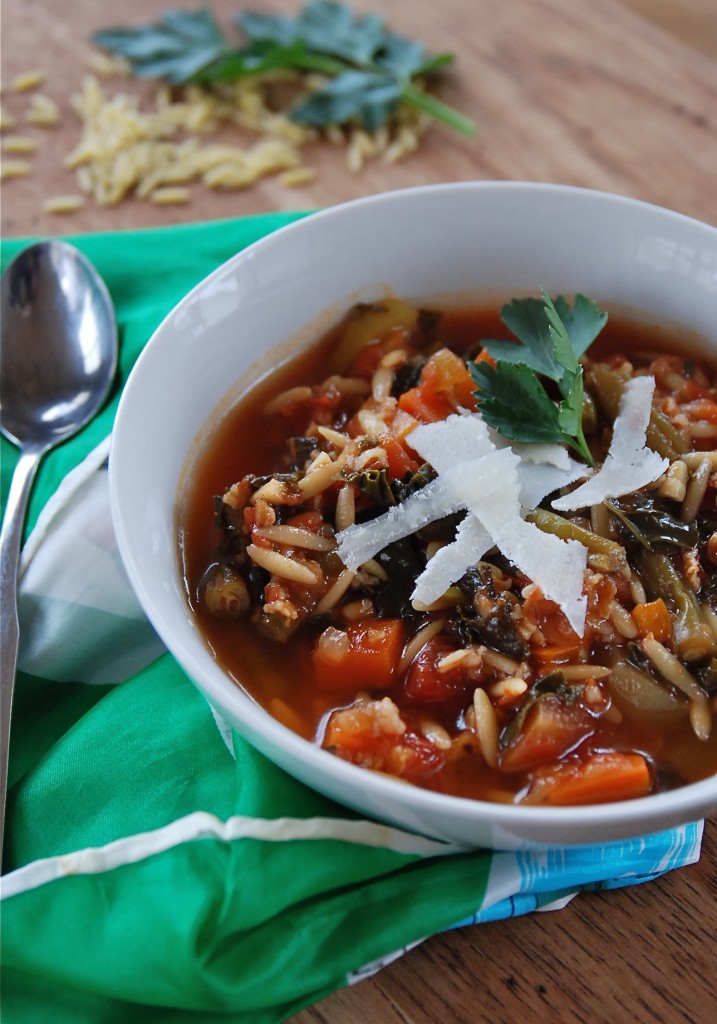
Minestrone requires little of the hard and fast rules; you add what you’ve got, really. What is in season, what is available, what it is you like. It needs a good tomato-y base, without a doubt. But beyond that, it lives for your interpretation. Thick or thin, meat or not, one, two or three vegetables or a whole produce aisle of them, pasta, legumes or rice- it’s all up to you. This version that served to warm my very cold, rattling bones on that damp, chilly night made light of too many singular remnants from the fridge; bits and pieces of plans that maybe fell through or were forgotten, or the one too many of any vegetable that hadn’t been used up yet. It had oceans of freshly chopped oregano and parsley tossed casually over it all, with thick shavings of sharp parm-reggiano. It was like planning a party at the last moment, not so confident of how it will all turn out and right in the middle of it, you realize that everyone in attendance has created an impeccable presence that elevates the whole of it to something utterly sublime. Well, that was my Minestrone that night; a delicious party in a stockpot, gathered with fingers crossed. My intensely perfect Minestrone.
Rounding it all out were the crunchy croutons, oiled, herbed and perfect for soaking up the broth. Beyond that, my perfect soup needed little else but a spoon, a quiet table with two smiling handsome faces, because no day in my life is complete without it ending right there, with them. The darkness settles, chasing out the light with violet and gold tones. The first spoonful I lift easily helps me cross the threshold from day to night, pushing the cold away, warmly coursing through me. There is a sigh, with half-closed eyes, a look and a feel that says “Perfect. This is just what I need.”
Kate’s Minestrone
1 large onion, diced
3 carrots, peeled and diced
3 celery stalks, with leaves, diced
4 cloves garlic, minced (adjust to taste, I am a garlic lover)
2 small zucchini, peeled and diced
1/2# fresh green beans, cut to 1/2″ pieces
1 bunch fresh kale, rough stems removed and chopped (sub chard, collards, or spinach)
1 32-oz pkg Pomi Tomatoes (use equivalent of your choice)
1/2 c. Orzo pasta (use small pasta of choice)
1/4 c. bulgur (optional, but I like the heft and nutrition it adds)
1/4 c. fresh chopped parsley and oregano (basil and thyme are also good)
Parm-Reggiano shavings
In a large stockpot, heat a small amount of oil and add the onions. Cook over medium heat, stirring occasionally, for about 5 minutes, or until the onions are opaque. Add the carrots, celery and green beans and cook, stirring, until the vegetables begin to brown a little, maybe 10-15 minutes. Moderate the heat to prevent them from scorching.
Add the garlic and a pinch of kosher salt. Stir to incorporate and cook for a few minutes until it’s wonderfully fragrant. Add the zucchini and the tomatoes and a quart of broth or water. Bring to a simmer and cook until the vegetables are tender enough to pierce with a fork, but not completely soft.
Add the kale, the pasta and the bulgur, if using. Depending on what pasta shape you use, cook until the pasta is al dente. Taste the soup and season with salt and pepper. Make sure the pasta is cooked, but also remember that it will continue to absorb liquid as the soup sits.
Ladle soup into bowls and top with a sprinkling of the fresh herbs and some shavings of cheese. Serve with a good bread, if desired.
RECIPE NOTES: This soup is wide open to interpretation, and can be modified in a multitude of different ways. Brown some good sausage and use the fat rendered to cook the vegetables for an added punch of flavor. This was a favorite way to make this soup back in my meat eating days.
Legumes can be added to this as well, and most Minestrone soups have them. Use a good quality white bean, such as Great Northern or Cannellini. Chickpeas would also be a good option.
As is the case with most soups, it develops a lot of flavor as it sits overnight in the fridge, but it will also absorb a lot of liquid in to the pasta and the bulgur (if you use the bulgur). Adding a little water to the soup before reheating will help loosen it.
Linking up to Soupapalooza 2012!!
“Come join SoupaPalooza at TidyMom and Dine and Dish; sponsored by KitchenAid, Red Star Yeast and Le Creuset”
January 18th, 2012
| 7 Comments »
I did not grow up loving mushrooms. I didn’t even like them, not one little bit. But I surely can’t blame myself, for my only exposure to them as a child of the ’70’s was from a can. And I can’t imagine anything more disgusting than canned mushrooms to a kid. No wonder I was never a fan of the fungus.
As I got older, I allowed a bit of mushroom to pass my lips; I loved them sauteed on a burger, or with a grilled steak. Provided I could have something in my mouth with them, they became only slightly more palatable to me, but I still struggled with texture, and that rich, loamy earthiness to them. Cover them with good red wine, and sauté them in copious amounts of butter and it was ok. Just ok though. Still, they weren’t on my favorites list by any means.
Then I had an epiphany, last summer. A major turning point in my culinary taste occurred at one of the wonderful events I attended last year with the Minnesota Food Bloggers group. It was at Cafe Levain in Minneapolis, and Chef Adam Vickerman created grilled portabella mushrooms, richly glazed in balsamic vinegar. I took a few tentative bites of them and my eyes were opened. I was re-born, re-newed and suddenly, all-out crazy for mushrooms. And to Adam’s credit, I’ve been slightly obsessed, and eating them weekly, ever since.
Mushrooms fit well into a healthy eating plan, and that makes them far more desirable given my all-enveloping obsession. Mushrooms have been revered in Eastern culture for thousands of years for their nutritional properties. Mushrooms are low in calories, fat-free, cholesterol-free and very low in sodium, yet they provide important nutrients, including minerals like selenium, potassium, copper, and vitamins such as riboflavin, niacin (the all important B vitamins) and vitamin D. And then there’s beta-glucans- something I’d never heard of before, and according to Mushroom Info:
“Beta-glucans, found in numerous mushroom species, have shown marked immunity-stimulating effects, contribute to resistance against allergies and may also participate in physiological processes related to the metabolism of fats and sugars in the human body. The beta-glucans contained in oyster, shiitake and split gill mushrooms are considered to be the most effective.”
So I can feel good about the amount of mushrooms passing my lips, and I like that. I can incorporate mushrooms in to just about any dish, but I hadn’t really done much with them in a soup so it was fun to come across this amazing Wild Rice & Mushroom soup recipe on The Kitchn, even better that I stumbled upon it as the coldest air of the month landed on Minnesota, making for a perfect backdrop to a steaming bowl of this thick and hearty soup.
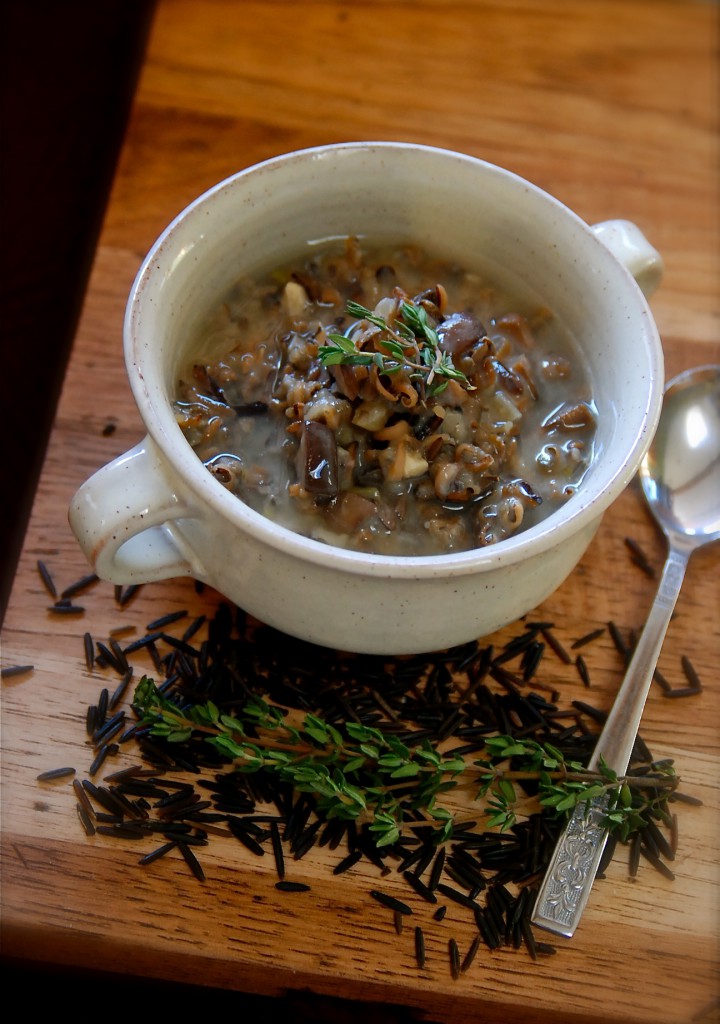
If you love a good wild rice soup with chicken, or turkey, you’ll love this lush recipe, which deeply browns mushrooms to develop their rich flavor. A bath of white wine and some good vegetable broth helps round out the simple but complex flavors. Wild rice was another food item I had to learn how to love, but thankfully, this wasn’t that difficult, and we’ve been enjoying wild rice soups for years. This one, with it deep earthy flavors and thick broth will be on repeat now. We all loved it, and soup is such a good leftover item to have on hand.
Wild Rice and Mushroom Soup
1 c. wild rice, washed
1 large onion, diced
4 celery stalks, diced (I love the flavor of the leaves and used a lot of those)
2 cloves garlic, minced
1 pound of mushrooms, rough chopped (I used baby portabella, but adding some porcini or oyster would be delicious)
1 t. fresh thyme
3 T. AP flour
1 c. white wine (I use pinot grigio in cooking. DO NOT use cooking wine from the grocer. Ugh)
1 Bay leaf
1-2 cheese rinds, optional
2 t. fresh rosemary, chopped
1 c. whole milk or heavy cream (I used a lot less, but adjust according to your taste)
1 T. cider vinegar
Salt and fresh ground pepper
Bring a pot of water to a boil and add the rice with 1 teaspoon of salt. Reduce to a simmer and cook for 40-50 minutes, or until the rice has burst open and is soft. You can leave it a bit underdone if you wish, and cook it to taste with the final soup. Drain the rice, reserving the cooking water to use in the soup if you wish. (I did this. Wow. What a flavor)
Meanwhile, heat a teaspoon of oil in a large dutch oven or stock pot over medium-high heat. Add the onions and celery with a pinch of salt and cook until softened and translucent, about 5-7 minutes. Turn the heat down to medium and add the mushrooms and another pinch of salt. Cook until the mushrooms have released their liquid and start to brown; this should take anywhere from 20-40 minutes depending on the size of your stock pot. I cooked them to a really deep brown. Don’t skip this step as this is where a lot of the flavor of your soup will come from.
Once they are nicely browned, add the garlic and thyme and cook for about a minute. Sprinkle the flour over the vegetables and stir to coat. Stir the flour until the mixture becomes sticky, and no visible dry flour remains. Increase the heat to medium-high and add the white wine. Stir and scrape the bottom of the pan, simmering until the wine has reduced and thickened.
Add the bay leaf, cheese rinds (if using) and stock or the cooking water from the rice. Bring to a boil, then reduce and simmer for about 20 minutes to blend the flavors. Add the rosemary, milk or cream and the wild rice, cooking for another 10-15 minutes, or until the soup has thickened to your liking. Stir in the cider vinegar, season with salt and pepper to taste.
Original recipe from The Kitchn, by Emma Christenson.
***This soup will thicken as it stands, and the rice absorbs more of the liquid. I’ve found that when re-heating it the next day, it tastes best to scoop out a serving and add water to loosen it up.
Linking up to Soupapalooza 2012!!
“Come join SoupaPalooza at TidyMom and Dine and Dishsponsored by KitchenAid, Red Star Yeast and Le Creuset”
November 21st, 2011
| 2 Comments »
This dish, if I wanted something really meaty and amazing, would be the first thing I turn to in order to quench that carnivorous desire.
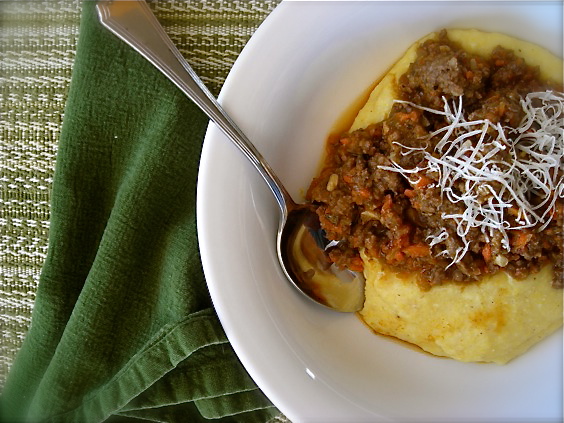
I made this back in late winter, in that transitional time between seasons where it isn’t always cold but it’s not exactly warm either, and it was perfect to fill our bellies with a heated depth to fend off the last of winter. The flavor is out-of-this-world good; rich and deep and lush on the tongue, and after the initial prep period, this is a no-brainer as it sits on the stove and gently simmers to a thick and delicious dish. Your house will smell amazing, and once it’s done, it can be spooned over pasta, grains or egg noodles, or like this version, atop a creamy dish of soft polenta.
With the onset of snow in Minnesota, this is a welcome choice for a cozy dinner.
Hearty Ragù with Soft Polenta
1# each ground beef and ground pork (i used 93/7 ground beef)
1/2 t. salt
1/4 t. fresh ground black pepper
2 small onions, peeled and cut to large pieces
2 carrots, peeled and cut to large pieces
2 stalks celery, with leaves, cut to large pieces
4 cloves garlic, peeled
2 T. olive oil
1 t. crushed dried rosemary leaves
1 14.5-oz can Muir Glen Organic Meridian Ruby tomatoes (or use equivalent of other kind)
1 c. dry red wine
1 quart good chicken stock
1/2 t. ground nutmeg
In a 4-qt dutch oven, brown the meat with salt and pepper over medium heat until no longer pink. Drain fat using a colander over a large bowl. Discard fat, set meat aside.
In large food processor, place onions, carrots, celery and garlic and process until finely chopped. In same dutch oven, add olive oil, vegetables and rosemary, cooking for about 15 minutes or until vegetables start to brown.
Add tomatoes and meat to pan, stir to combine. Cook approximately 15 minutes, until tomatoes darken slightly. Add red wine, increase heat to medium-high and cook until liquid reduces by about half. Add chicken stock, reduce heat to low and simmer, stirring occasionally, for 3-4 hours. Stir in nutmeg in final minutes of cook time.
KATE’S NOTES: For extra richness in this dish, I added about a half cup of heavy cream with the chicken stock. I think it made an exceptional addition. When you add the stock, the mixture will be very loose, like a soup. It will reduce as it simmers though. I did not cover the pan as it cooked, but I doubt it will make much difference, although it may take longer for the liquid to reduce if it’s covered.
From Cascina Spinasse, Seattle Washington, and Chef Jason Stratton
from the Muir Glen Tomato Vine Dining Tour recipe booklet
Creamy Soft Polenta
1/2 c. stone ground corn meal
1 c. fat free milk
1 c. water
1 t. butter
Salt and pepper as needed
In a heavy medium saucepan, bring milk, water and butter to a boil then add cornmeal in a thin stream, whisking constantly. Once cornmeal is added, whisk for several minutes to insure smooth consistency. Bring to a simmer, reduce heat to low and cover the pan, leaving lid ajar to release steam. Simmer polenta for about 10 minutes, stirring often to keep it from scorching, then add 2-3 tablespoons of water. Stir to combine, replace cover (leaving it ajar) and simmer for 10-15 minutes more, stirring regularly, scraping the bottom to prevent scorching. Add about 2-3 more tablespoons of water at this point, stir to combine and cook for about 5 more minutes, stirring regularly. Taste for texture; it should be smooth, and not at all grainy. If any graininess remains, add a few more tablespoons of water and cook until smooth. Serve immediately. Makes about 2 servings
KATE’S NOTES: Be aware that Polenta, as it cooks, bubbles like molten lava, and it can be dangerous if not kept partially covered. Keep the heat low to prevent the bubbles from exploding violently. And when you stir the polenta as it cooks, make sure you are scraping the pan bottom thoroughly. I used a flat edge wooden spatula for this. A heat resistant rubber spatula would also be a good option.
March 5th, 2010
| 10 Comments »
I hope that I never get to a point in my life where I think I’ve seen it all. Especially when it comes to pancakes.
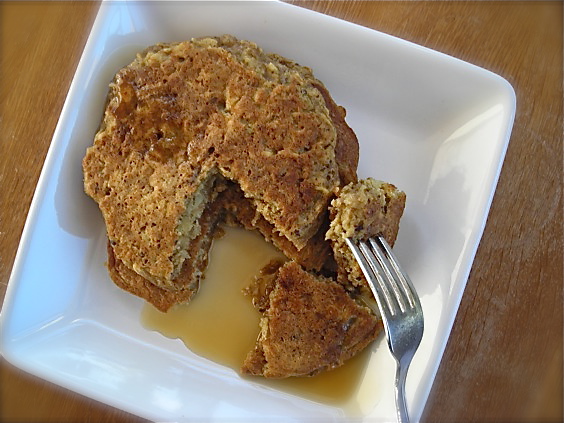
If I had to pick a favorite breakfast option, pancakes might be fighting for top billing. While I do really enjoy pan roasted potatoes, especially with onion and pepper and topped with a soft egg, there is something so versatile and endlessly appealing about the simple pancake. With your standard batter, you can create an enormous palette of tastes and flavors- apple and spice, banana and pecan, chocolate-cherry, blueberry buckwheat, peach with almonds, mango and coconut….. I mean, wow. What can’t you put in a pancake? Or maybe more so, what wouldn’t you put in??
Oatmeal is the same blank breakfast slate. A simple bowl can be doctored in dozens of ways, and yes, many of them in the same manner as listed above. They all work, so why wouldn’t oatmeal and pancakes work together? I’m here to tell you, with much enthusiasm and horn-trumpeting that they absolutely do. It’s a happy breakfast marriage.
These oatmeal pancakes, courtesy of Molly, were the epitome of hearty and satisfying, and so easily zipped into what breakfast should be all about, with maybe the tiny exception that you have to plan just slightly ahead with this recipe. While you probably could use quick oats and get away with it, I strongly recommend using the thick cut version to get the best affect that these stick-to-your-ribs cakes can offer, such as a breakfast that lasts for a good long time. Really, there isn’t much point to eating in the morning if your tummy doesn’t remember it even a few short hours later.
And there’s no better idea on a chilly Saturday morning than to pull a bowl of soaked oats from the fridge and quickly mix them into a substantial batter that sizzles from your griddle, filling the house with the aroma of ‘Come and get it!’.
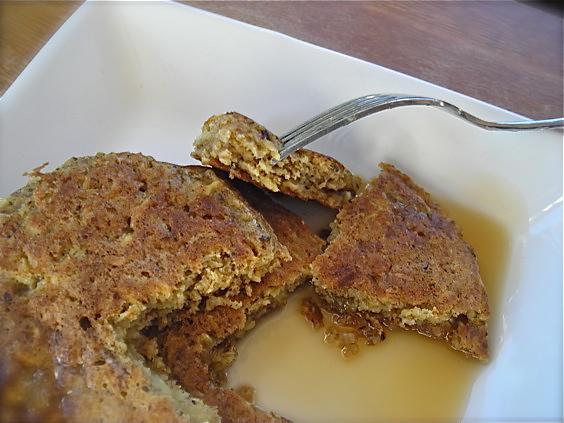
If you’ve ever had Baked Oatmeal, where you mix your oats with eggs, brown sugar and spices and bake them into a thick pudding, then the flavor of these pancakes will be familiar to your mouth. The oats, so soft and tender from their overnight soak in buttermilk, bake into a firm pancake that happily soaks up your maple syrup. I’m really not up for much on any given Friday night, and I owe all the remaining energy from the week to dinner prep and a bit of couch time with Netflix on Demand and my two favorite guys, but I somehow managed to stop myself from climbing the stairs to my bedroom, at 9:15 no doubt- and whoa does that make me sound OLD- and instead turning around to the kitchen to prep the oats for the next morning. I even washed and grated an apple into the mix, shredded in some lemon zest and then cleaned up my little mess. That’s motivation. It made the trip up the stairs to bed even better knowing that I was set for morning, because, you know there’s just something about Saturday morning that begs and whispers just the slightest bit for something special, something that clearly says “Oh yes. It’s the weekend.”
Oatmeal Pancakes
2 c. rolled or thick oats
2 c. buttermilk (or like I did, soy milk with lemon juice and zest mixed in- yum!)
3/4 c. AP flour (I subbed whole wheat)
2 T. sugar (I used turbinado, but brown I think would be best)
1 t. EACH baking powder and baking soda
1/2 t. sea salt
2 large eggs, slightly beaten
1/2 c. melted butter (equiv. to 1 stick. I only used 4 T., or half a stick and it was almost too much for my taste)
The night before, mix oats and buttermilk in a large bowl. Cover with plastic wrap and chill overnight. In the morning, remove from the refrigerator and stir gently.
Blend the flour, sugar, powder and soda and salt together in a large measuring cup. Add the eggs and melted butter to the oat mixture and stir well. Then gently fold in the dry ingredients. Do not overmix.
Heat your griddle or skillet and add about 1/4 cup of the batter. Allow to cook until browned on one side, then carefully flip and cook until golden brown on the second size. Serve topped with maple syrup or fresh fruit.
KATE’S NOTE’S– There isn’t much that I think can improve these pancakes, but I do feel that a bit of cinnamon and fresh grated nutmeg would really be stellar. As I mentioned, I grated an apple into the oats the night before. It could also be done in the morning too.
|













